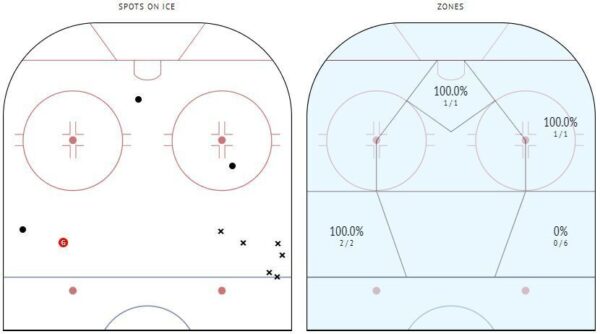Analytics Approach: Ty Nelson
Welcome to Analytics Approach, a series that takes a deep dive on 2022 NHL Draft prospects from the perspective of possession and shot attempts. Driving play through carrying the puck and putting the puck in high danger areas are critical traits to becoming not just NHL players, but superstars as well.
In this edition, I tracked the puck possession metrics for right-shot defenseman Ty Nelson of the North Bay Battalion.
I tracked four recent games by Nelson and added up his metrics to see what patterns developed as I watched him play. The games tracked are noted below and all metrics are tabulated at 5-on-5, even-strength:
- October 8th, 2021 against Sault Ste Marie
- October 11th, 2021 against Sudbury
- October 15th, 2021 against Mississauga
- October 17th, 2021 against Barrie
Nelson, No. 22 in FCHockey’s Preliminary ranking for the 2022 draft, is a phenomenal skater who has a nice blend of top-end speed, acceleration and agility to make an impact from the back end. It’s been a solid start to the season for Nelson with North Bay from a production standpoint, but it’s how he uses his skills that make him a joy to watch.
With incredible anticipatory skills, Nelson can diagnose passes that are about to happen and attack the target of the pass.
In the above clip, Nelson sees the play setting up and waits until the opportune moment to head towards the recipient of the puck. His ability to identify plays like this and use his incredible short area quickness to close in on the opponent allow him to break up the play and prevent the opponent from doing anything with the puck.
This type of play is very common in Nelson’s game and is very difficult to see as he disguises his intentions so well. By breaking up plays like this, Nelson contributes to change of possession in favor of his team and by default, suppresses shot attempts and controlled zone time by the opponent.
These anticipatory skills of Nelson are put to use when carrying the puck as shown in the clip below.
Seeing a chance to break out, Nelson curls up ice and generates a lot of speed quickly. He takes the pass and because he has already generated enough speed, is able to fend off the attacker and skate away through the neutral zone and into opponent territory.
Every decision by Nelson is so calculated and done in a way that sets him up for success. Had he not seen the play developing above and made a cognizant decision to get up to top speed for that breakout, it would have been broken up easily by the forechecker. Instead, it turned into controlled zone time for North Bay in the offensive end.
As shown in the clip above, Nelson again makes a play with other intentions in mind. Passing the puck off, he immediately starts skating up ice which turns into an odd-man rush for North Bay.
Having the offensive mindset and instincts to see an opportunity to take this rush chance is a special trait of Nelson. It’s a characteristic that leads to increased puck possession and play driving which is an excellent ability for a defenseman to have.
Below is a glossary of terms used for this tracking effort which should look familiar to those with some experience in analytics. The focus in this article is on puck possession and the shot attempts associated with them to better understand how impactful a player is on shot attempts for and against.
Glossary:
SA For – Shot Attempts For
SA Against – Shot Attempts Against
CF% – Percentage of Shot Attempts For (Team and Opponent)
SC For – Scoring Chances For
SC Against – Scoring Chances Against
SCF% – Percentage of Scoring Chances For (Team and Opponent)
Primary Shot Assist – Pass that leads to a Shot Attempt
Puck Possession Metrics:
| Controlled Entries | 5 | Controlled Exits | 5 |
| Dump-Ins | 5 | Uncontrolled Exits | 5 |
| Failed Entries | 4 | Failed Exits | 4 |
| Entry Rate (%) | 35.7 | Exit Rate (%) | 57.1 |
With Nelson being the first defenseman in this series to be tracked, it’s not clear just how well his possession numbers are. Nelson was excellent at getting the puck out of his end with a positive ratio of controlled exits (57.1%).
However, it should be noted that while this successful controlled exit rate isn’t as high as forwards seen in this article series, Nelson was frequently taking the best option available to him that didn’t risk his team giving up a dangerous chance. This helps explain the higher number of uncontrolled exits.
In the clip above, it’s clear that Nelson has the ability to carry the puck out of his own end. He is so smooth with his skating and crossovers that it seems so effortless getting up to speed and out of his zone with possession of the puck.
What was interesting about tracking Nelson was the amount of dump-ins he performed, especially when he had the opportunity to gain the zone with possession. This is one aspect of Nelson’s game that could certainly be improved and is more of a mental change since he has the ability to carry the puck at will.
Team & Individual Shot Attempt Metrics:
| Shot Attempts For | 40 | Primary Shot Assists | 1 |
| Shot Attempts Against | 42 | Passes To Slot | 0 |
| Corsi For % | 48.8 | Individual Shot Attempts | 9 |
| Scoring Chances For | 9 | Individual Shots On Goal | 4 |
| Scoring Chances Against | 8 | Player Isolation Contributions (%) | 25.0 |
| Scoring Chances For (%) | 52.9 |
It was expected for Nelson to not have as great of an impact on shot attempts as a forward, but with his skills he has significant potential to improve in this area.
Isolating Nelson’s individual contribution to shot attempts, he certainly left a lot to be desired and this was backed up on the tape. Nelson is great at getting the puck out of his end and through the neutral zone but his lack of overall time in possession of the puck in the offensive zone is directly contributing to his lack of individual impact on shot attempts.
To give a better view of where Nelson is taking his shots from, Instat Hockey has a shot map for this season to date. All shot attempts in the map below are at 5-on-5 and include shots on goal as well as shot attempts that missed the net or were blocked.

Again, it was expected that as a defenseman, Nelson would not have a map with a ton of marks in the home plate area. The lack of sample size at this stage of the season also reduces the cluster but early on a trend can be seen in Nelson’s shot attempts.
He is taking the majority of his shot attempts from the perimeter which are low danger and don’t generate as many scoring chances.
While his shot isn’t overly powerful at this stage of his development, Nelson is at least strategic at getting some of these perimeter shots through traffic and on net but would benefit from walking in towards the high slot when possible.
In this final clip, Nelson sets up the entire sequence with his speed and offensive instincts. With how easy he makes plays like this seems, it’s only natural that he should take more opportunities to carry the puck as they’re presented to him.
Nelson is part of a strong group of right-shot defensemen who are likely to be drafted in the first round of the 2022 NHL Draft. It will be interesting to see how he develops his game this season as he has the tools to play a style similar to Cale Makar but needs to use them more effectively and more often.
Skating is Nelson’s high-end trait that will help him have a strong season and the more he relies on that, the more of a positive impact he’s going to have on a nightly basis. At the present moment, Nelson is more likely on the back end of a strong group of right shot defensemen in this class but does have potential to raise his stock.

